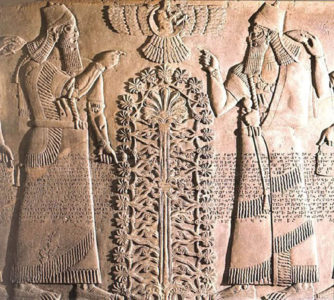Hemp Origins, Evolution & History

 It is nearly impossible to write about the origins of hemp without referencing its psychoactive cousin marijuana, because they originated as one, as Cannabis, and their histories are as intertwined as they are separable. Its origins and evolution are as complex and compelling of a subject as its multifaceted utilization and intricate composition. Initially, distinctions between hemp and marijuana were based on the route it took during its evolution, its adaptation and then later by its narcotic effect. Its history has been laced with the confusion of, is it one in the same or are they different and how? But it was not until the last couple of centuries that a scientific analysis of the percentage of one chemical component, tetrahydrocannabinol (THC), became the one distinguishing (and demonizing) factor that separated and characterized the two.
It is nearly impossible to write about the origins of hemp without referencing its psychoactive cousin marijuana, because they originated as one, as Cannabis, and their histories are as intertwined as they are separable. Its origins and evolution are as complex and compelling of a subject as its multifaceted utilization and intricate composition. Initially, distinctions between hemp and marijuana were based on the route it took during its evolution, its adaptation and then later by its narcotic effect. Its history has been laced with the confusion of, is it one in the same or are they different and how? But it was not until the last couple of centuries that a scientific analysis of the percentage of one chemical component, tetrahydrocannabinol (THC), became the one distinguishing (and demonizing) factor that separated and characterized the two.
There is still so much that scientists need to uncover to fully comprehend the ancient history of Cannabis, and there are conflicting theories, but most researchers agree that its origins were in Central & South Asia. To this day, the flowering herb grows wild across vast grassland regions of Eurasia that spans western China and Mongolia through Kazakhstan and south toward India and the Middle East. But this does not explain how this one plant evolved so distinctly into either industrial hemp or the psychoactive marijuana. A much greater force than man could have been responsible—the force of nature.
One convincing theory is that tens of thousands of years ago, cannabis plants were physically separated into two growing regions, likely due to ice sheets; one in Europe and the other in south Asia. Over time, this geographical separation led to differences in the appearance, composition and ideal growing conditions, resulting in the classification of at least two cannabis species: Cannabis sativa L. (hemp) in Europe, and Cannabis indica and Cannabis sativa in south Asia. The more northern, Chinese and European adaptations of the plant flourished as industrial hemp, being utilized mainly for its fibrous stalk and its oily, nutritional seed, while the south Asian and Middle Eastern version evolved more towards its psychoactive properties for ceremonial, recreational, or medicinal purposes. Scientific studies support the idea that cannabis was first used for its psychoactive compounds in the mountainous regions of eastern Central Asia, then later spread to other regions of the world. Its versatility, however, was known throughout the regions where the plant grew.
 Ethnobotanical and archeological researchers speculate that the plant was first domesticated somewhere around 12,000 BCE. If this estimate is correct, domestic cannabis would be among the earliest agricultural crops domesticated by humans. Experts suggest that the plant was likely traded among various cultures on the precursor to the silk road (130 B.C.)—the oldest and possibly one of the most important trade routes in human history. Although the first “discovery” of cannabis occurred long before human groups traded amongst each other via such routes. Human migration, however, was responsible for the spread of both C. indica and C. sativa seeds throughout the world.
Ethnobotanical and archeological researchers speculate that the plant was first domesticated somewhere around 12,000 BCE. If this estimate is correct, domestic cannabis would be among the earliest agricultural crops domesticated by humans. Experts suggest that the plant was likely traded among various cultures on the precursor to the silk road (130 B.C.)—the oldest and possibly one of the most important trade routes in human history. Although the first “discovery” of cannabis occurred long before human groups traded amongst each other via such routes. Human migration, however, was responsible for the spread of both C. indica and C. sativa seeds throughout the world.
Ancient historical timelines of cannabis have included some of the following dates and findings:
10,000+ BCE Use of hemp cord in pottery identified at ancient village site located in the area of modern-day Taiwan.
8,000 BCE Ancient Mesopotamians made hemp cloth.
6,000 BCE Cannabis seeds and oil used for food in China.
4,000 BCE Textiles made of hemp are used in China and Turkestan.
2,737 BCE First recorded use of cannabis as medicine by Emperor Shen Neng of China.
2,000-800 BCE Bhang (dried cannabis leaves, seeds and stems) is mentioned in the Hindu sacred text Atharvaveda (Science of Charms) as “Sacred Grass”, one of the five sacred plants of India.
700-600 BCE The Zoroastrian Zendavesta, an ancient Persian religious text of several hundred volumes refers to bhang as the “good narcotic.”
700-300 BCE Scythian tribes leave Cannabis seeds as offerings in royal tombs
600 BCE Hemp rope appears in southern Russia.
200 BCE Hemp rope appears in Greece. Chinese Book of Rites mentions hemp fabric.
100 BCE First evidence of hemp paper in China.
100-0 BCE The psychotropic properties of Cannabis are mentioned in the newly compiled herbal Pen Ts’ao Ching.
500-600 The Jewish Talmud mentions the euphoriant properties of Cannabis.
850 Vikings take hemp rope and seeds to Iceland.
900 Arabs learn techniques for making hemp paper.
900-1000 Scholars debate the pros and cons of eating hashish. Use spreads throughout Arabia.
1155-1221 Persian legend of the Sufi master Sheik Haydar’s personal discovery of Cannabis and his own alleged invention of hashish with its subsequent spread to Iraq, Bahrain, Egypt and Syria.
1200 1,001 Nights, an Arabian collection of tales, describes hashish’s intoxicating and aphrodisiac properties.
1300 Ethiopian pipes containing marijuana suggest the herb has spread from Egypt to the rest of Africa.
1533 King Henry VIII fines farmers if they do not raise hemp for industrial use.
1549 Angolan slaves brought cannabis with them to the sugar plantations of northeastern Brazil.
1600 England begins to import hemp from Russia.
1606-1632 French and British cultivate Cannabis for hemp at their colonies in Port Royal (1606), Virginia (1611), and Plymouth (1632).
Cannabis may be one of the oldest agricultural crops, but it took a while for it to arrive in the Americas. Historical records reveal that industrial hemp was introduced into the New World (Canada) by French explorers, into the U.S. by British colonists, and into South America by the Spanish or Portuguese, which all makes perfect sense. (Although there are also theories that its arrival pre-dated all of these and came to North America via the Bearing Straight). It is fairly safe to say that the psychoactive counterpart arrived in North America via Mexico via either South America or the Caribbean Islands and there are contradicting theories as to whether it was introduced to those regions by slaves or by their owners to sedate them. The history of Cannabis in the Americas is extensive and fascinating and will be saved for another issue.
This article is only a mere abbreviation of the sophisticated and seemingly mysterious origins and evolution of this worldly plant. What modern day scientists (and even more so the general public) understand about its medicinal and utilitarian applications is still ‘only the tip of the iceberg’. But one thing we do know for sure is that this plant has co-existed with humans on this planet for millennia and possibly even pre-dated human evolution. The origins and history of Cannabis and its boundless uses on our planet has been, and remains, the topic of volumes of books, reports, documentaries and infinite research and studies.
Having some basic understanding of how this plant has played such a vital and vibrant role in the history of world cultures and ancient civilizations, along with how it has traversed the planet and adapted to a variety of environments, will hopefully bring a new perspective and a heightened appreciation for this phenomenal plant—Cannabis.
Donna is a Horticulturist and Cannabis advocate. She recently transplanted her business—HelloHemp!—to Quepos. For more info, questions, or comments: hellohempar.com, donnaporter@hellohempar.com or 6007-7779.
